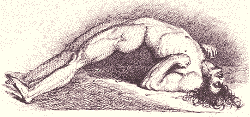Tetanus: Cause, Symptoms and Treatment

Reproductive cells (spores) of Clostridium tetani are found in the soil and enter the body through a skin wound. Once the spores develop into mature bacteria, the bacteria produce tetanospasmin, a neurotoxin (a protein that poisons the body's nervous system) that causes muscle spasms. In fact, tetanus gets its nickname — lockjaw — because the toxin often attacks the muscles that control the jaw.
Symptoms
The hallmark feature of tetanus is muscle rigidity and spasms.
In generalized tetanus, the initial complaints may include any of the following:
- Irritability, muscle cramps, sore muscles, weakness, or difficulty swallowing are commonly seen.
- Facial muscles are often affected first. Trismus or lockjaw is most common. This condition results from spasms of the jaw muscles that are responsible for chewing. A sardonic smile — medically termed risus sardonicus — is a characteristic feature that results from facial muscle spasms.
- Muscle spasms are progressive and may include a characteristic arching of the back known as opisthotonus. Muscle spasms may be intense enough to cause your bones to break and your joints to dislocate.
- Severe cases can involve spasms of the vocal cords or muscles involved in breathing. If this happens, death is likely, unless medical help is readily available.
In cephalic tetanus, in addition to lockjaw, weakness of at least 1 other facial muscle occurs. In two-thirds of these cases, generalized tetanus will develop.
In localized tetanus, muscle spasms occur at or near the site of your injury. This condition rarely progresses to generalized tetanus.
Neonatal tetanus is identical to generalized tetanus except that it affects the newborn infant. Your baby may be irritable and have poor sucking ability or difficulty swallowing.
Treatment
According to the CDC, tetanus is fatal in about 11 percent of cases, but fortunately, it can't be spread from person to person — you need direct contact with C. tetani to contract the disease. Today, tetanus immunization is standard in the United States, but if you are injured in a way that increases tetanus risk (i.e. stepping on a rusty nail, cutting your hand with a knife, or getting bitten by a dog), a booster shot may be necessary if it's been several years since your last tetanus shot.
According to the CDC, since the 1970s, only about 50 to 100 cases of tetanus are reported in the United States each year, mostly among people who have never been vaccinated or who did not get a booster shot. And WHO says that globally there were about 15,500 cases of tetanus in 2005.
|